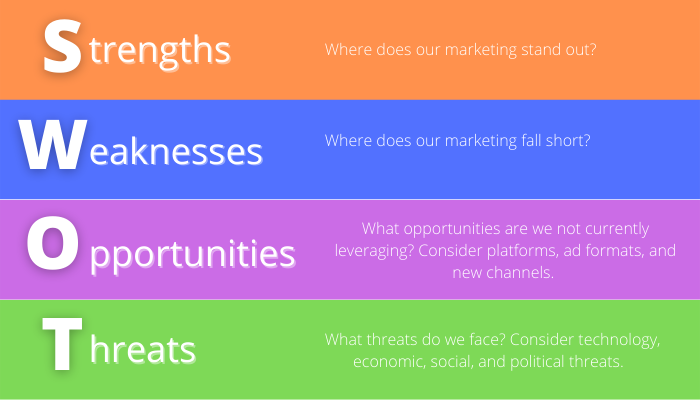THE TOPIC YOU WILL FIND IN THIS ARTICLE:
1 . Basic Understanding of SWOT Analysis.
2 . WHAT ARE THE #5 Steps to Creating an Effective SWOT Analysis?
3 . The Role of SWOT Analysis in Business Decision-Making
4 . How to Use SWOT Analysis in Market Research?
5 . What Are the Top 20 Advantages of SWOT Analysis?
Table of Contents
Basic Understanding of SWOT Analysis.
SWOT analysis is a strategic planning method that examines the strengths, weaknesses, opportunities, and threats of a project. It entails declaring the aim of the business enterprise or project and determining whether internal and external elements will assist or hinder the achievement of that goal. The method is thought to have been thought up by Albert Humphrey. In the 1960s and 1970s, he ran a conference at Stanford University with the help of information from the Fortune 500.
Opportunities and threats come from the outside, while strengths and weaknesses come from the inside. Most of the time, a company’s strengths and weaknesses have to do with its resources, like its products, people, finances, and technology.
Opportunities and threats usually refer to things in the outside world, like market trends, customer needs, and the actions of competitors.
1. Strengths
Strengths refer to the resources and competitive advantages a company has over its competitors. Some of these can be a well-known brand, loyal customers, money, efficient production processes, and access to new markets. Strengths can also be things that can’t be seen, like a company’s good name or its ability to come up with new ideas.
2 . Weaknesses
Weaknesses are the ways in which a company isn’t as good as its competitors. These areas include outdated equipment, a lack of financial resources, high costs, a lack of expertise, or limited access to new markets. Weaknesses should be addressed to ensure that a company can compete effectively.
3 . Opportunities
Opportunities are things like changes in technology, market trends, or new customer needs that come from the outside and give a company a chance to become more competitive. Companies should think carefully about the opportunities they have so they can choose the best ones.
4 . Threats
Threats are things outside of a company that can hurt its ability to compete, like new competitors, changes in technology, or market trends. Companies should be aware of potential threats and be prepared to respond to them.
The SWOT analysis is a powerful tool for figuring out what is going on inside and outside of a company. The SWOT analysis can also help companies figure out where they could improve and make plans to do so.
WHAT ARE THE #5 Steps to Creating an Effective SWOT Analysis?

A SWOT analysis can also help students and professionals learn more about their own strengths and weaknesses. By understanding how their strengths and weaknesses interact with opportunities and threats in the environment, people can make strategic decisions that increase their chances of reaching their goals.
Step 1: Gather Information
Gathering information about yourself, your business, or your industry is the first step in making a useful SWOT analysis. This can be done through various means, including interviews with stakeholders, industry trends research, and current customer feedback assessment.
Step 2: Identify Strengths and Weaknesses
Once you have all the information you need, you can start to figure out the strengths and weaknesses of your business or yourself. These can be anything from a unique product or service offering to a well-trained staff or a strong customer base. On the other hand, weaknesses are areas where you or your business may be lacking. This could be because they don’t have a strong presence in the market, don’t have enough resources, or don’t have a competitive edge.
Step 3: Identify Opportunities and Threats
The next step in making a useful SWOT analysis is to look at the environment and find opportunities and threats. Opportunities refer to any external factors that could benefit your business or yourself. These can be anything from a new market opening up to a change in consumer preferences or a new technology becoming available. On the other hand, threats are anything outside of you or your business that could hurt you or your business. These can be anything from a competitor entering the market to a change in customer demand or a new regulation
Step 4: Analyze the SWOT
Once you know what the strengths, weaknesses, opportunities, and threats are, you need to figure out how they all work together. This will help you determine which of your strengths and weaknesses are most important for each opportunity and threat. For example, if a new technology comes out, you should focus on what you’re good at in that area to make the most of the chance. On the other hand, if a competitor enters the market, you should work on your weaknesses to lessen the threat.
Step 5: Make a Strategy
The last step in making a useful SWOT analysis is to make a plan based on what you learned from the analysis. This plan should list the steps you or your business can take to take advantage of the opportunities and reduce the risks. This can mean anything from buying new technology to hiring more people to start a new marketing campaign. By taking these steps, you can make sure you use the strengths and weaknesses you’ve found to your advantage and take steps to reduce any possible risks.
Business owners and executives can learn a lot about their current situation and plan for the future by doing a practical SWOT analysis .By following the five steps above, you can make sure you are gathering the right information, finding the relevant strengths and weaknesses, analyzing how they interact with each other, and making a plan to take advantage of the opportunities and reduce the threats. By taking these steps, you can ensure that your business is taking advantage of its strengths and weaknesses and taking steps to achieve its goals.
The Role of SWOT Analysis in Business Decision-Making

SWOT analysis looks at both the inside and outside of an organization to figure out its strengths, weaknesses, opportunities, and threats. It can help with business strategy, developing new products or services, marketing, and running the business. The primary purpose of SWOT analysis is to help organizations make better decisions by considering internal and external factors that may affect the organization’s performance.
When performing a SWOT analysis, it is essential to be objective and realistic. It is also important to think about internal and external forces, such as the organization’s structure, processes, and resources, as well as environmental and industry trends. For a SWOT analysis to be useful, you need to know enough about both the internal and external environments.
The first step in a SWOT analysis is identifying the organization’s strengths. Strengths are the unique capabilities, resources, and competitive advantages that the organization has. These can be things you can touch, like money, assets, and people, or things you can’t touch, like brand recognition, reputation, and customer loyalty. Once the strengths are identified, the next step is identifying the weaknesses. Weaknesses are the areas where the organization lacks and can improve. These can include a lack of resources, outdated technology, inefficient processes, or employee training.
The next step in the SWOT analysis is to find the opportunities. These outside factors can give the organization new ways to grow and get bigger. Examples of opportunities include new markets, new technologies, and partnerships. Finally, the last step is to identify the threats. These are the external factors that could potentially harm the organization’s performance. Examples of threats include new competitors, changes in customer demands, and economic downturns.
The organization can learn a lot about its internal and external environments from the SWOT analysis. This information can be used to help identify both short-term and long-term strategies. For example, the strengths can be used to take advantage of current opportunities, and the weaknesses can be used to come up with plans to fix these problems. By looking at the opportunities, you can find new markets and products, and by looking at the threats, you can come up with ways to lessen their effects.
Overall, SWOT analysis is a valuable tool for decision-making. It helps organizations understand their internal and external environments and find opportunities and threats that they might have missed. When organizations think about both internal and external factors, they can make better decisions and come up with plans to use their strengths and fix their weaknesses.
How to Use SWOT Analysis in Market Research?

SWOT analysis can be used in market research to get a full picture of how the market is doing right now. By knowing the market’s strengths, weaknesses, opportunities, and threats, businesses can make smart choices about the best strategies to follow.
Step 1: Identify Strengths
In market research, the first step in using SWOT analysis is to figure out what the market does well. Strengths are characteristics that distinguish a market from its competitors. Here are some examples of strengths:
- A firm brand name.
- Unique products or services.
- A loyal customer base.
- Strong financials.
- A well-established supply chain.
Step 2: Identify Weaknesses
The next step is to identify weaknesses in the market. Weaknesses refer to factors that may limit the success of the market. Some things that can be fixed are not knowing enough about your customers, not having enough products or services, having bad finances, or using old technology.
Step 3: Identifying Opportunities
The third step is to identify opportunities in the market. Opportunities refer to factors that can be leveraged to increase the market’s success. Examples of opportunities can include new customer segments, technological advancements, or emerging trends.
Step 4: Identify Potential Threats
The final step is to identify threats to the market. Threats refer to factors that could limit the success of the market. Threats can come from other markets, changes in consumer tastes, or economic downturns, among other things.
Once a company knows its strengths, weaknesses, chances, and risks, it can make plans for each of these areas. For instance, businesses can use the results of the SWOT analysis to come up with plans to take advantage of opportunities, fix weaknesses, reduce risks, and make the most of their strengths.
For market research, SWOT analysis is a very useful tool. If a business knows the market’s strengths, weaknesses, opportunities, and risks, it can choose the best strategies.
- SWOT analysis is a strategic planning method that examines the strengths, weaknesses, opportunities, and threats of a project.
- Most of the time, a company’s strengths and weaknesses have to do with its resources, like its products, people, finances, and technology.
- Companies should be aware of potential threats and be prepared to respond to them.
- The SWOT analysis is a powerful tool for figuring out what is going on inside and outside of a company.
- The SWOT analysis can also help companies figure out where they could improve and make plans to do so.
- A SWOT analysis can also help students and professionals learn more about their own strengths and weaknesses.
- By understanding how their strengths and weaknesses interact with opportunities and threats in the environment, people can make strategic decisions that increase their chances of reaching their goals.
- Opportunities refer to any external factors that could benefit your business or yourself. This plan should list the steps you or your business can take to take advantage of the opportunities and reduce the risks.
- The Role of SWOT Analysis in Business Decision-Making SWOT analysis looks at both the inside and outside of an organization to figure out its strengths, weaknesses, opportunities, and threats.
- The primary purpose of SWOT analysis is to help organizations make better decisions by considering internal and external factors that may affect the organization’s performance. When performing a SWOT analysis, it is essential to be objective and realistic.
I believe you found a lot of important information in this blog. We had to do a lot of research for this blog. 
Be a daily visitor in bizshill for such awesome content and business case studies. Share with your friend and let them know
Browse other blogs:
- #8 FACTS EVERYONE SHOULD KNOW ABOUT AUTOMATED TELLER MACHINE
- #15 AMAZING FACTS ABOUT MARK ZUCKERBERG: ONE OF THE TOP RICH PERSON IN WORLD
- ENERGY PRODUCTION OF BIG COMPANIES
- WHAT ARE THE FANTASTIC LEARNING WE CAN LEARN FROM JEFF BEZOS?
- HOW AND WHERE TO INVEST AS A BEGINNER

